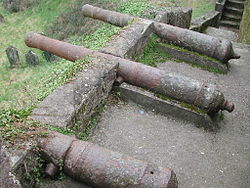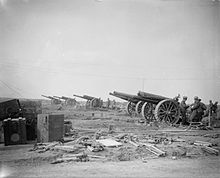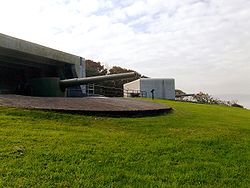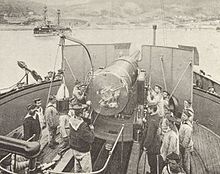- Artillery battery
-
In military organizations, an artillery battery is a unit of guns, mortars, rockets or missiles so grouped in order to facilitate better battlefield communication and command and control, as well as to provide dispersion for its constituent gunnery crews and their systems.[citation needed] The term is also used in a naval context to describe groups of guns on warships.
Contents
Land usage
Historically the term 'battery' referred to a group of ordnance systems (commonly cannon) in action, used as field artillery or in a siege of a fortress or a city. Such batteries could be a mixture of cannon, howitzer, or mortar types. A siege could involve many batteries. The term also came to be used for a group of cannon in a fixed fortification, for coastal or frontier defence, and for the placement of artillery in a temporary field position during a battle. During the 18th century 'battery' began to be used as an organizational term for a permanent unit of artillery in peace and war, usually organised with between six and twelve ordnance pieces, often including cannon and howitzers. By the late 19th century this use had become normal and mostly replaced earlier terms for artillery units such as company or troop.
In the 20th century the term was generally used for the company level sub-unit of an artillery branch including field, air-defence, anti-tank and position (coast and frontier defences). Artillery operated target acquisition emerged during World War 1 and were also grouped into batteries and have subsequently expanded to include the complete intelligence, surveillance, target acquisition and reconnaissance (ISTAR) spectrum. Twentieth-century firing batteries have been equipped with mortars, guns, howitzers, rockets and missiles.
During the Napoleonic Wars some armies started grouping their batteries into larger administrative and field units. Administratively batteries were usually grouped in battalions or squadrons, which were further grouped into regiments, simply 'group' or brigades, that may be wholly composed of artillery units or combined arms in composition. Groups of batteries combined for field combat employment became known as the Grand Batteries. To further concentrate fire of individual batteries, from World War I they were grouped into 'artillery divisions'. Coastal artillery sometimes had completely different organizational terms based on shore defence sector areas.
Batteries also have sub-divisions which vary across armies and periods, but often translate into the English 'platoon' or 'troop' with individual ordnance systems called a 'section', or 'sub-section' where a section comprises two artillery pieces.
The rank of a battery commander has also varied, but is usually a lieutenant, captain or major.
The number of guns, howitzers, mortars or launchers in an organizational battery has also varied, with the calibre of guns usually being an important consideration. In the 19th century 4 to 12 pieces guns was usual as the optimum number to maneuver into the gun line. By late 19th century the mountain artillery battery was divided into a gun line and an ammunition line. The gun line consisted of six guns (five mules to a gun) and 12 ammunition mules.[1]
During the American Civil War, artillery batteries often consisted of six field pieces for the Union Army and four for the Confederate States Army, although this varied. Batteries were divided into sections of two guns apiece, each section normally under the command of a lieutenant. The full battery was typically commanded by a captain. Often, particularly as the war progressed, individual batteries were grouped into battalions under a major or colonel of artillery. See Field Artillery in the American Civil War.
In the 20th century it varied between four and twelve for field artillery (even 16 if mortars), or even two pieces for very heavy pieces. Other types of artillery such as anti-tank or anti-aircraft have sometimes been larger. Some batteries have been 'dual-equipped' with two different types of gun or mortar, and taking whichever was most appropriate when they deployed for operations.
The term 'battery' has also been used in association with warships. Early warships that mounted guns, such as the ship of the line, mounted dozens of cannons, carronades, and other guns in broadsides, sometimes on several decks. This remained the standard layout for centuries, until new designs, such as the revolving turret, made it obsolete.
One of the first rotating turrets was designed by John Ericsson, for use on the American ironclad USS Monitor. Other designs used open barbettes to house their main batteries on rotating mounts. Both designs allowed naval engineers to dramatically reduce the number of guns present in the battery, by giving a handful of guns the ability to concentrate on either side of the ship.
A revolution in ship armament occurred in 1906, with the completion of HMS Dreadnought. In previous battleship designs, the primary battery often consisted of four large caliber guns in two turrets, one in the front of the ship, and one aft. The ships also had a mixed secondary battery of smaller guns, but were also intended to be used offensively. The differences in gun calibers and ranges made it difficult to accurately judge shell splashes, and thus to fire the guns accurately, which led to decreased effectiveness of the ships. Dreadnought's design did away with the offensive secondary battery, and replaced it with ten heavy caliber guns, and a smaller secondary battery to be used for self defense. This leap in armament made all other battleships obsolete.
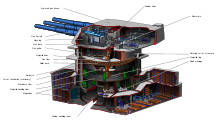 Cut-away illustration of the 16 inch gun turret on Iowa class battleships that formed the primary battery.
Cut-away illustration of the 16 inch gun turret on Iowa class battleships that formed the primary battery.
Often, ships have a primary battery for offensive purposes, and a secondary and sometimes even a tertiary battery for self defense. An example of this was the German battleship Bismarck, which carried a primary battery of eight 15 inch (380mm) guns, along with a secondary battery of twelve 5.9 inch (150mm) guns for defense against destroyers and torpedo boats, as well as a tertiary battery of various anti-aircraft guns ranging in caliber from 4.1 inch (105mm) to 20mm guns. Many later ships used dual-purpose guns to combine the secondary battery and the heavier guns of the tertiary batteries, in order to simplify the design.
Most modern vessels have largely done away with conventional artillery, instead using cruise and guided missiles for most offensive and defensive purposes, respectively. Guns are retained for niche roles, such as the Phalanx CIWS, a multi-barrel rotary cannon used for point defense, or the Mark 45 5 inch, which is used for close defense against surface combatants and shore bombardment.
Modern battery organization
In modern battery organization, the military unit typically has 6 to 8 howitzers or 6 to 9 rocket launchers and 100 to 200 personnel. In the U.S. Army, generally a towed howitzer battery has 6 guns, where a self-propelled battery (such as an M 109 battery) contains 8. They are subdivided into:
- Field batteries, equipped with 105 mm howitzers or equivalent;
- Medium batteries, equipped with 155 mm howitzers or equivalent;
- Heavy batteries, which are equipped with guns of 203 mm or more calibre, but are now very rare; and
- Various more specialised types, such as anti-aircraft, missile, or Multiple Launch Rocket System batteries.
- Headquarters batteries, which themselves have no artillery pieces, but are rather the command and control organization for a group of firing batteries (for example, a regimental or battalion headquarters battery).
The battery is typically commanded by a captain in U.S. forces and is equivalent to an infantry company. In United Kingdom and Commonwealth forces a battery commander, or "BC" is a Major (like his infantry company commander counterpart). However, in these armies the battery commander leads the 'tactical group' and is usually located with the headquarters of the infantry or amoured unit the battery is supporting. The battery position is commanded by the BC's second-in-command, the Battery Captain (BK). Increasingly these direct support battery commanders are responsible for the orchestration of all forms of fire support (mortars, attack helicopters, other aircraft and naval gunfire) as well as artillery. General support battery commanders are likely to be at brigade or higher headquarters.
A US battery is divided into the following units:
- The firing section, which includes the individual gun sections. Each gun section is typically led by a staff sergeant (US Army Enlisted pay grade E-6); the firing section as a whole is usually led by a lieutenant and a senior NCO.
- The fire direction center (FDC), which computes firing solutions based on map coordinates, receives fire requests and feedback from observers and infantry units, and communicates directions to the firing section. It also receives commands from higher headquarters (i.e. the battalion FDC sends commands to the FDCs of all three of its batteries for the purpose of synchronizing a barrage).
Other armies can be significantly different, however. For example: the basic field organization being the 'gun group' and the 'tactical group'. The former being reconnaissance and survey, guns, command posts, logistic and equipment support elements, the latter being the battery commander and observation teams that deploy with the supported arm. In these armies the guns may be split into several fire units, which may deploy dispersed over an extended area or be concentrated into a single position. It some cases batteries have operationally deployed as 6 totally separate guns, although sections (pairs) are more usual.
During the Cold War NATO batteries that were dedicated to a nuclear role generally operated as 'sections' comprising a single gun or launcher.
Groupings of mortars, when they are not operated by artillery, are usually referred to as platoons.
See also
Notes
- ^ p.263, Bethell
References
- Bethell, Henry Arthur, Modern Artillery in the Field: A Description of the Artillery of the Field, Macmillan and Co., limited, 1911
External links
Categories:- Artillery units and formations
- Military units and formations by size
- Military units and formations of the Middle Ages
Wikimedia Foundation. 2010.

